
Click here to view the Swedish version of this article.
Note: The images in this article are free to use for media, as long as you credit ”Glenn Lindberg/Vi Bilägare”.
The screens in modern cars keep getting bigger. Design teams at most car manufacturers love to ditch physical buttons and switches, although they are far superior safety-wise.
That is the conclusion when Swedish car magazine Vi Bilägare performed a thurough test of the HMI system (Human-Machine Interface) in a total of twelve cars this summer.
Inspiration for the screen-heavy interiors in modern cars comes from smartphones and tablets. Designers want a ”clean” interior with minimal switchgear, and the financial department wants to lower the cost. Instead of developing, manufacturing and keeping physical buttons in stock for years to come, car manufacturers are keen on integrating more functions into a digital screen which can be updated over time.
So in what way have these screens affected safety? Vi Bilägare gathered eleven modern cars from different manufacturers at an airfield och measured the time needed for a driver to perform different simple tasks, such as changing the radio station or adjusting the climate control. At the same time, the car was driven at 110 km/h (68 mph). We also invited an ”old-school” car without a touchscreen, a 17-year-old Volvo V70, for comparison.
One important aspect of this test is that the drivers had time to get to know the cars and their infotainment systems before the test started.
Designers want a ”clean” interior with minimal switchgear

Each moment during the test is timed separately.
No backlighting
Tesla was not the first to introduce a touchscreen, but the American carmaker has always offered bigger touchscreens than most manufacturers, containing more of the car’s features. Even the windshield wipers are controlled through the touchscreen.
BMW iX also offers a touchscreen, but not as big as Tesla’s, and also more physical buttons. But that’s no guarantee for a system which is easy to use. The BMW’s infotainment system has lots of features, but it also has one of the most complex and complicated user interfaces ever designed.
Another sin is committed by Volkswagen and Seat. In order to save money, the touch-sensitive climate controls below the screen in the ID.3 and Leon are not backlit which make them completely invisible at night.
Voice control
The carmakers are keen to point out that many features now can be activated by voice. But the voice control systems are not always easy to use, they can’t control every function and they don’t always work as advertised, which is why the voice control systems were not tested in this experiment.
The results speak for themselves. The worst-performing car needs 1,400 meters to perform the same tasks for which the best-performing car only needs 300 meters.

It doesn't get any simpler than this. The 2005-model year Volvo V70 shows that physical controls are easier to use than touchscreens.

MG Marvel R has the biggest, and by far the worst, screen in our test.
Big differences
- The easiest car to understand and operate, by a large margin, is the 2005 Volvo V70. The four tasks is handled within ten seconds flat, during which the car is driven 306 meters at 110 km/h.
- At the other end of the scale, Chinese electric car MG Marvel R performs far worse. The driver needs 44.6 seconds before all the tasks are completed, during which the car has travelled 1,372 meters – more than four times the distance compared to the old Volvo.
- BMW iX and Seat Leon perform better, but both are still too complicated. The driver needs almost a kilometer to perform the tasks. Lots can happen in traffic during that time.
- Dacia Sandero and Volvo C40 perform well although they both have touchscreens. However, they are not overloaded with features. Volvo shows that a touchscreen doesn’t need to be complicated.
We have also measured the angle at which the driver has to look down to operate the controls. By photographing the same driver in all cars, we find that the driver has to lower the line of sight by 56 degrees to view the lower end of the screen. Compare that to only 20 degrees in the Mercedes GLB.
The results
| Car | Time to perform four tasks, seconds | Score, 1–5 |
|---|---|---|
| BMW iX | 30.4 | 4.0 |
| Dacia Sandero | 13.5 | 3.75 |
| Hyundai Ioniq 5 | 26.7 | 3.5 |
| Mercedes GLB | 20.2 | 3.25 |
| MG Marvel R | 44.9 | 2.5 |
| Nissan Qashqai | 25.1 | 4.25 |
| Seat Leon | 29.3 | 3.25 |
| Subaru Outback | 19.4 | 4.0 |
| Tesla Model 3 | 23.5 | 3.75 |
| Volkswagen ID.3 | 25.7 | 2.25 |
| Volvo C40 | 13.7 | 3.5 |
| Volvo V70 (2005) | 10.0 | 4.5 |


In BMW's iX, it's easy to get lost in all of the functions and features.
- Activate the heated seat, increase temperature by two degrees, and start the defroster.
- Power on the radio and adjust the station to a specific channel (Sweden’s Program 1).
- Reset the trip computer.
- Lower the instrument lighting to the lowest level and turn off the center display.
- Vi Bilägare is Sweden's biggest car magazine, launched in 1930.
- We review new and used cars and are also performing world-exclusive tests of headlights and rust proofing.
- Vi Bilägare also offers readers unique insights into car ownership with our long-term tests, where we each year purchase five new cars.
- We are completely independent and not associated with any carmaker.
Ämnen i artikeln
Genom att anmäla dig godkänner du OK-förlagets personuppgiftspolicy.

